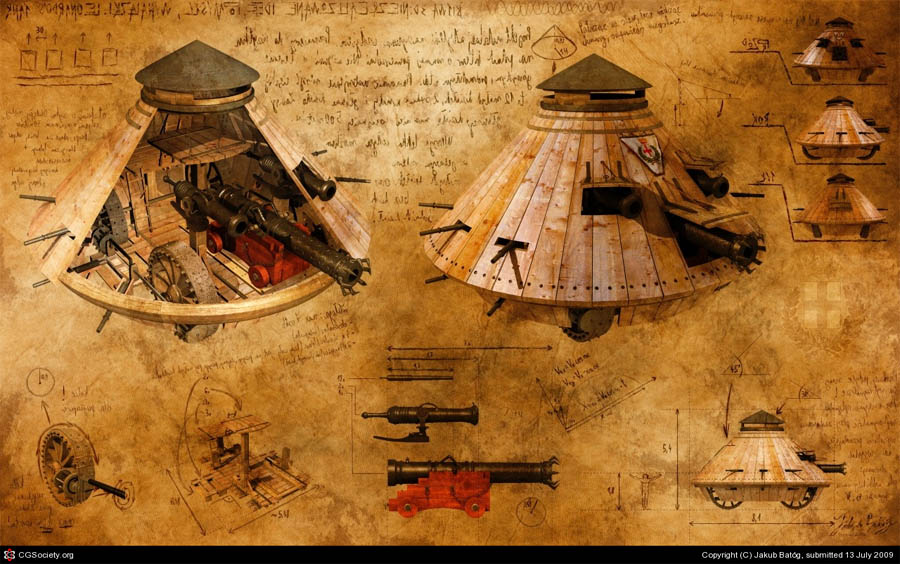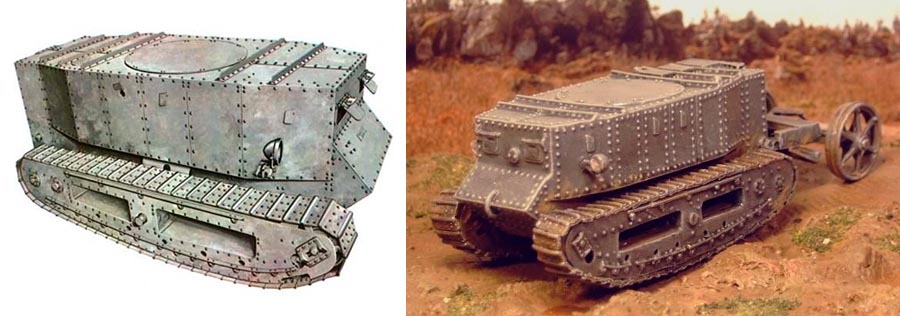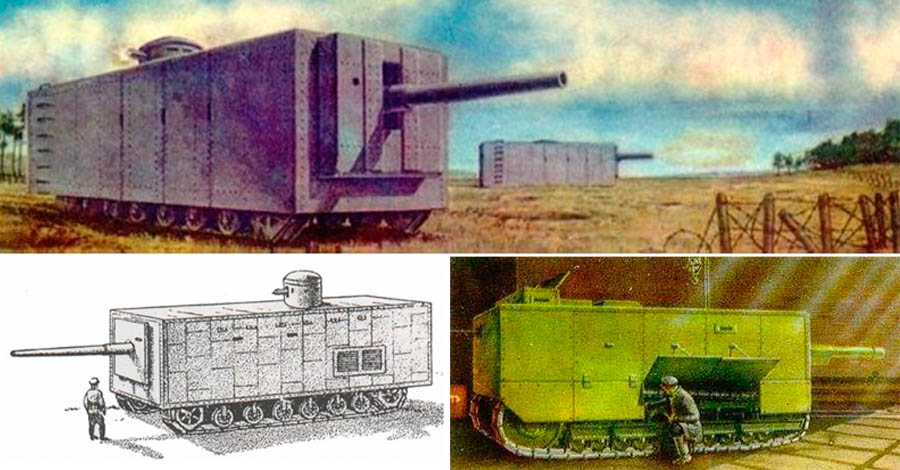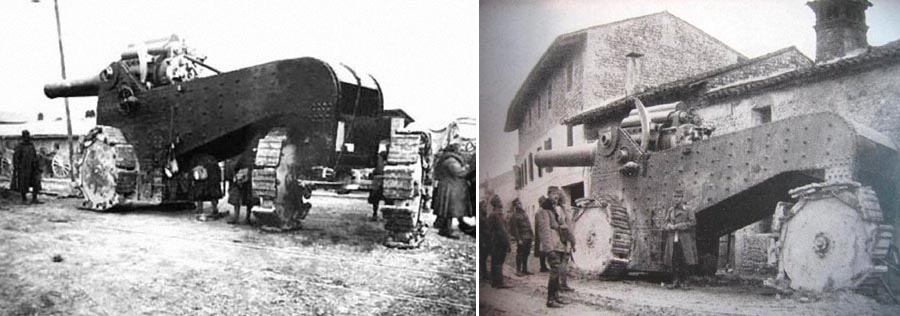From Early Tank Ideas to Enormous Pre-WW1 Steam Tanks
Cataloguing the machines of destruction may seem like a thankless job (when you think about how much pain and misery they brought to mankind), but the sheer ingenuity of military engineering is certainly fascinating. It's that "anything-goes, testing be damned, let's quickly put it into production" attitude that leads to frenzied arms races, as well as technology breakthroughs. This is how we ended up with laser-tanks, spherical bomb-tanks and nightmarish land dreadnoughts, in the short period of the last hundred years or so - all conceived and built by super-powers in the name of winning righteous wars (any war, it may be argued, can be considered "righteous" by their participants, if they absorb enough propaganda and ideology).
So we look at some of the weirdest tank examples here at AMJG, marveling at their uninhibited design coupled with war-time mythology, brute force and potential for intimidation (seeing how the race to "build a better tank" quickly turned into "building a bigger tank", for example).
It all started in the 14th century. We have a record of a "pre-tank" machine, called "The Fighting Unicorn" (left) - a fragment of a page from the work of Mariano di Jacopo (aka Mariano Taccola) from Sienna:

The armored body of this weird tank precursor concealed a number of soldiers (who must've been of a somewhat slight build to fit in there), all running in step - with the "unicorn horn" either lowered into a "charge" position, or simply used to pound on the helmets of astonished enemies.
The image above right shows another early tank concept: a sketch by Leonardo Da Vinci, one of fifteen found in his notebooks that contain weapon and defensive systems designs (among them are some wildly imaginative ideas like "mobile walls", or the sinister "cluster bombs"...
Here is a better graphic representation of this complex weapon:

Interestingly, the idea of a turtle-like tank shape found its realization much later, in the 1930s, in this Venezuelan armored vehicle:

As you can see from the wonderful recreation of Da Vinci's concept below (courtesy Discover Channel's Doing Da Vinci show), this amazing tank idea from 1482 features a tortoise-shaped armor which literally bristles with cannons all around. Some even call this design "shock and awe" of the 15th-century battlefield, as it certainly would create fear and havoc among enemy soldiers.

Seen on the right in the image above is the Da Vinci's Armored Assault Vessel and the already mentioned mobile walls: "as the enemy used ladders in an attempt to breach the walls, the levers were engaged to move the rails built into the walls that the ladders were leaning on, causing them to become unstable and eventually fall".
More Leonardo Da Vinci war machines - a pivoting radial barrage canon found in the Codex Atlanticus (left) and the multi-barreled machine gun (right, sketched in 1480):

Moving right along to the Victorian Age we have a mention of first caterpillar tracks (invented in their crudest form in 1770 by Richard Edgeworth) being used in the Crimean War, where a "relatively small number of steam powered tractors with the caterpillar track were seen manoeuvring around the battlefield’s muddy terrain.". The idea of armored assault vehicle certainly was floating in the air but needed better engines and more commitment from political powers.
Here is the armored steam-powered vehicle proposed in 1855 for the British Armed Forces... apparently this design did not advance past a certain Lord Palmerston (who happened to be Prime Minister at the time) who deemed it "utter nonsense" and not worthy of further development:

Meanwhile in France, the strangest idea of a caterpillar-like armored train on tracks was proposed by Eduard Boyen in 1874, boasting an incredible weight of 120 tons and a crew of two hundred people! -

In Germany engineers came up with the Mobile Gunpoint 3-ton unit in 1885 ("Gruson 5.3cm L/24 Fahrpanzer"). It was brought to the battlefield by horse, or on rails - and then fired 1.75 kg projectiles from its 53mm gun. it went into mass production in 1890:

In England, in 1902, Frederick Simms designed an armored vehicle on wheels (he called it a "motor-war car") which could also be converted to a track version. Its two revolving machine guns were developed by Hiram Maxim:

In the years leading to the First World War, the British government was not keen on developing such "pretty mechanical toys" as tanks (or as they called them "Land ships"), preferring to concentrate on cavalry and infantry instead. It took backing of some prominent political figures (Winston Churchill among them) to advance the idea - and so the "Little Willie", and then the "Big willie" were born in 1915:


The "Little Willie" had a huge limitation in that it was unable to cross trenches. Crossing trenches was one of the requirements put forward by Winston Churchill when he commissioned the design of a vehicle "capable of resisting bullets and shrapnel, crossing trenches, flattening barbed wire, and negotiating the mud of no-man’s land".
Crossing trenches was a challenge not only for British engineers. Also from 1915 is this bizarre "Machine Boirault" tested for the French Army as a trench crossing vehicle:

Meanwhile in Russia...
...another monster was taking shape on the drawing boards: the Mendeleev's Super Heavy Tank, 1911. It was intended to have a 256 horse power engine and would weigh 86 tons:

The square and brutal shape of this war machine was later repeated in the Rybinsk Tank, 1916 (lower right corner, above). These were developed based on the tractor chassis of the Rybinsk Tractor Factory - and were quite similar to the squarish hull of the French medium tank St. Chamond, for example. It's interesting that the word "tank" comes from the strong resemblance of early armored hulls to various water carriers and liquid tanks, and so the name stuck for good - even when the shapes of tanks changed.
Mendeleev's Super Heavy Tank also featured a revolutionary "elastic" suspension system, as can be seen from the drawings below:

Also in 1916, the Russians came up with the "Vezdekhod" concept (All-Terrain Tank). It had a prominent forward slant of the body, enabling better traction and climbing various obstacles - and also perhaps influencing rhomboid tank designs of the British from the same period:

The "Vezdekhod" (translated as "Go Anywhere") vehicle was strangely streamlined in the first prototypes, could be outfitted with both wheels or tracks, and was slated to go into production in the final form shown on the right:



And yet for all its streamlined curves, this was pretty tame and conventional layout compared to this:

The Tsar Tank!
This lovely mechanism, designed by N. Lebedenko in 1914, could very well be the Biggest Tank Ever Built. It was certainly one of the strangest: a monster of a tank, with a distinctive steampunk-friendly shape, a full 40-ton battle machine with two very large wheels 9 meters in diameter. It was called "Tsar Tank" after Tsar Nikolaj, who helped finance it - and it also had another sinister name "Netopyr" (a vampire bat):


It was hoped that such unusual configuration of wheels will enable the Tsar Tank to pass any obstacle. Unfortunately during the initial trial run the smaller wheel got stuck in a ditch... and the engines did not have enough power to get the rear wheels out. So in the end this magnificent vehicle (looking like some wild modernist sculpture) stayed in the middle of the forest till 1926, when it was dismantled for scrap metal.



Weird "Iron Horse" War Machine from Italy, 1914
This was an Italian mobile gun unit, used in the First World War. It was equipped with a 305mm cannon, with a shooting range of almost 18 kilometers. It was allegedly used during the shelling of the Austrian fortifications in the Alps:

The Giant Destroyers of the Future
You've seen some of the outrageous concepts that appeared worldwide in the years leading to the First World War. Well, the imagination of certain artists of "super-science" publications ran even wilder, eagerly providing colossal visions (or rather, nightmares) that were to dominate public minds for decades to come. Here is an example from Popular Science magazine (December, 1916):


Another Mega Tank concept graced the pages of the "War Budget" publication in 1916:

And we finish today with the German Mega-Tank nightmare vision, taken from the October 21st, 1916, issue of the German news weekly, Die Wochenschau. "Fighting machines of the future: battle between a gigantic trenchdestroyer and a powerful electrically-driven circlecruiser":

Source
